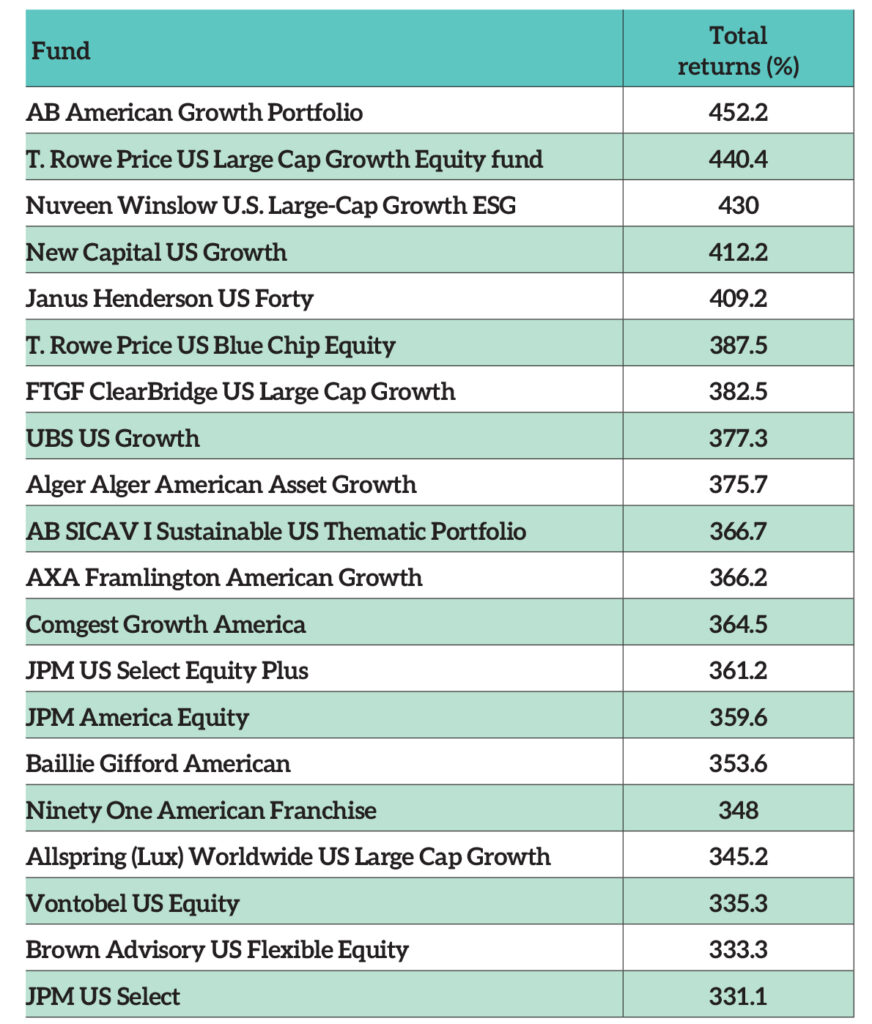The S&P 500’s high returns have been immensely difficult to beat over the past decade – so much so that only 20 active funds outperformed the index.
Many managers played their hand at generating a return for investors that was greater than the market through active management, but only 15% of the funds in the IA North America sector with a 10 year track record did so successfully.
The average US fund made a total return of 200.5% over the period whilst the S&P 500 flew ahead at 327.8%, meaning investors would have been better off with a tracker in most cases – and for a fraction of the cost.
But how did this small handful of active funds beat the world’s best performing market when so many others failed?
The 20 active IA North America funds that beat the S&P 500 over the past 10 years

Ajay Vaid, senior investment research analyst at Square Mile, said it is no surprise that they are all deeply biased towards quality growth or high growth stocks. The prolonged period of low inflation and interest rates that characterised the past decade was the perfect environment for these stocks to thrive.
Vaid highlighted Baillie Gifford American as a prime beneficiary of this. Manager Gary Robinson, like all managers at the firm, only held companies that he deemed to be the most exceptional on the market.
Yet he went one step further than most growth managers and was not afraid to take highly concentrated positions in a small number of stocks he had the most conviction in, according to Vaid. His 10 biggest holdings often accounted for over half of his £2.6bn portfolio – today it stands at 55%.
See also: Is there any point investing in the US actively?
Only holding extremely high-growth stocks meant performance was volatile at times, but it ultimately led to some of the best returns on the market, with returns soaring 353.6% over the past decade.
So whilst periods of painful volatility were amplified further by its highly concentrated positions, investors who held on to Baillie Gifford American were “handsomely rewarded” in the long run, according to Vaid.
Another shared theme throughout the top-performing funds is their high allocation to technology. Rob Morgan, chief analyst at Charles Stanley, said many on the list “are bordering on closet tech funds”.
“Though the managers would, I’m sure, argue this is simply a result of going where the investment prospects are best rather than any deliberate bias,” he added. But with the likes of Baillie Gifford American holding half of their assets (50.3%) in tech and communications companies, this bias is hard to ignore.
See also: How to invest in an interest rate falling world
Morgan pointed to two funds that have a slightly more balanced exposure across different sectors, making their outperformance over the past decade “all the more impressive”.
One such fund was JPM US Select, which was up 331.1% over the past decade while taking a less pronounced sector bias. The £1.3bn fund collectively has a 42% allocation to companies it classifies as semi and hardware, software and services, or media businesses.
While it did make the lowest return on the list, RSMR’s head of marketing and business development James Senior said JPM US Select can “complement funds which have a more aggressive style bias” that dominate the sector.
“This is a core fund that should provide a balanced return over most market conditions although it is less likely to perform well in late cycle, deep value markets or those that are momentum led,” he added.
Alternatively, Morgan also highlighted AXA Framlington American Growth as a standout diversifier. It is “a flatter, less punchy portfolio” (with 37.8% allocated to tech and communication stocks) but still outperformed the S&P 500 with a 366.2% return of the past decade.
Morgan said manager Stephen Kelly’s skill in identifying companies with clear competitive advantages and strong organic growth profiles – which has often steered him away from the large-cap names that most US managers gravitate to – has “really delivered for investors” over the long term.
Senior added that Kelly’s strategy of only buying growth at a reasonable price means investors holding AXA Framlington American Growth are “likely to be better rewarded when companies are being priced with more of a reference to financial fundamentals than in consideration of short-term market sentiment”.
See also: Is a bitcoin allocation a diversification ‘cheat code’?
However, while these active funds have bucked the trend in beating the US market, Vaid warned that their future performance was not without risk.
Growth managers have recovered from a deeply challenging post-covid downturn (with the IA North America sector having fallen 9.7% in 2022) but the rebound of the past two years has been driven by a very small number of stocks.
If market returns don’t broaden out, then the ability for active managers to outperform the index will be dependent on them holding substantial positions in a highly concentrated pool of companies.
“While this would naturally benefit those managers with a growth investment style, the concentration within the market was such that just having exposure wasn’t enough – funds had to be overweight to this handful of names in order to outperform,” Vaid explained. “So far into 2024, the market has broadened out a little, however the Magnificent Seven (excluding Tesla) remains a strong driver of returns.
“The expectation of rate cuts in the US should benefit growth companies, however market concentration could remain an issue for active fund managers. Therefore, future successes may depend on how benchmark aware each strategy is, and if the market’s returns broadened out.”










